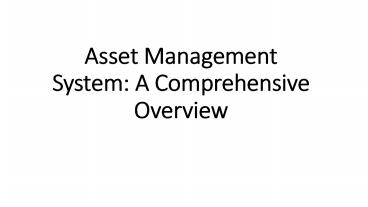Asset Management System: A Comprehensive Overview - PowerPoint PPT Presentation
Title:
Asset Management System: A Comprehensive Overview
Description:
When a company has a large number of assets and equipment, it is important to keep track of each one. Keeping track of each asset is a difficult task; this is where asset labeling comes in. It is extremely beneficial to the organization in terms of keeping track of assets, and it allows you to save valuable information about each one. This blog will provide a complete overview of asset labeling. So, without further ado, let's get started! – PowerPoint PPT presentation
Number of Views:94
Title: Asset Management System: A Comprehensive Overview
1
Asset Management System A Comprehensive Overview
2
- When a company has a large number of assets and
equipment, it is important to keep track of each
one. - Keeping track of each asset is a difficult task
this is where asset labeling comes in. - It is extremely beneficial to the organization in
terms of keeping track of assets, and it allows
you to save valuable information about each one. - This blog will provide a complete overview of
asset labeling. So, without further ado, let's
get started!
3
What Is Asset Labeling?
- The process of assigning a unique asset identity
or code to each asset is known as asset labeling.
- It assists in the identification of each asset
and provides essential information. - The asset label contains a unique random number
that is used to track the asset. - The asset is labeled with this label.
- This one-of-a-kind random number is saved in the
asset tracking software's database so that when
an asset label is scanned, it retrieves all of
the asset's information. - When you know the exact location of an asset, it
helps with operations because employees don't
have to waste time looking for it.
4
- It informs the organization that it is in the
right place at the right time. - As a result, we can say that the asset label
advantage organizations by increasing
productivity.
5
What Is the Importance of Asset labeling?
- Asset labeling is important, especially when an
organization has a large number of assets. - It facilitates the identification of each asset.
- It saves time because they don't have to keep
track of assets. - All they need to do with an asset handheld
scanner is scan the asset, and the system will
automatically retrieve the information. - Asset labeling is also useful during the audit
and physical verification processes. - Without a doubt, it saves time and makes you more
efficient. - Asset labeling is essential for running an
effective asset tracking system. - It is also useful for asset maintenance because
it keeps track of assets.
6
Benefits of Asset Labeling
- 1. Accurate Asset Positioning
- 2. Assist in the maintenance of assets
- 3. Check-in and Check-out of Assets
- 4. Asset Theft and Misplacement Prevention
7
1. Accurate Asset Positioning
- When assets are frequently moved from one
location to another, asset labels come in handy. - This is a situation where asset loss is more
likely than usual. - Employees do not have to look for or locate
required assets because this software allows them
to quickly obtain asset location, ensuring that
there is no confusion. - You can get important information about assets by
using the right type of asset tag, such as where
it is located, who is using it, and how often the
asset is used. - This type of data is extremely useful when making
business decisions.
8
2. Assist in the maintenance of assets
- Asset labels are useful not only for indicating
asset location but also for providing data that
allows the asset tracking system to easily
schedule asset maintenance. - As a result, asset labeling is essential to
effective asset management. - You can get alerts for each asset maintenance
with the right asset tracking system, which means
you don't have to remember and keep track of
maintenance manually.
9
3. Check-in and Check-out of Assets
- Asset check-in and check-out can help you keep
track of your assets. - The asset tag or label plays an important role in
this process in order to achieve this goal. - Employees become more responsible for the assets
they use as a result of the check-in/check-out
process. - Employees are reminded to return assets during
the check-in checkout process, and if they
forget, they will be penalized.
10
4. Asset Theft and Misplacement Prevention
- Asset theft and asset misplacement are problems
that many businesses face. - When a theft occurs, the organization not only
loses direct assets but also has to reinvest in
assets by purchasing them. - Furthermore, when assets are misplaced, the
organization loses valuable time, and operations
are hampered. - Both of these factors contribute to a lack of
productivity.
11
Final Words
- Asset tags are used to keep track of assets,
particularly when they are transferred from one
site to another. - Asset tags assist in a variety of ways, including
asset maintenance and asset utilization history. - It simplifies asset accounting in order to meet
tax and auditing requirements. - Asset tags unquestionably help the organization
in delivering high-quality work. - However, there are a variety of asset labels
available on the market. - Some are made of paper, while others are made of
plastic, so you must determine which type of
asset label will be most effective for your
company.































